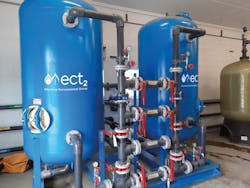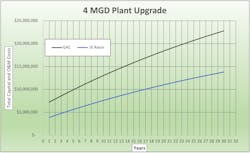The Challenge
In April 2024, the EPA finalized a National Primary Drinking Water Regulation (NPDWR) that established legally enforceable levels, called Maximum Contaminant Levels (MCLs), for six PFAS in drinking water. These MCLs range from 4 nanograms per liter (ng/L or parts per trillion) to 10 ng/L. Many existing drinking water treatment plants (DWTPs) use a combination of coagulation, flocculation, and filtration technologies that, alone, are not capable of achieving these strict levels.
The Solution
A cost-effective option for PFAS removal and MCL compliance is the addition on an anion exchange resins (IEX) treatment as a “bolt-on” to an existing DWTP. The dual mechanism of sorption and ion exchange for PFAS removal using IEX can achieve non-detect levels (i.e. MCLs or lower). Whereas Granular Activated Carbon (GAC) has also been historically used to treat PFAS, GAC is limited in its ability to treat short-chain PFAS, and requires longer Empty Bed Contact Times (EBCTs) to meet MCLs. This translates in GAC requiring larger and most costly media vessels, more frequent media changeouts, increased operation and maintenance costs, and more PFAS waste – an important consideration with possible future designation of PFAS as a hazardous waste. In many cases, retrofit of an existing DWTP involves only the addition of the IEX vessels as the end of the current treatment process, and relocation of the disinfection stage.
Our Team’s Experience
ECT2 recently conducted a lifecycle cost analysis on behalf of a municipal drinking water client, comparing the addition of an IEX treatment train versus a GAC treatment train to treat PFAS. In this case, assume a 4 MGD drinking water plant, with influent PFAS concentrations in the order of 100 ng/L, and treatment goals of non-detect (~ 2 ng/L for regulated PFAS). ECT2 conducted a rapid-scale small column testing of media, which evaluated PFAS removal effectiveness, and developed:
- A design basis
- Process flow diagrams
- Anticipated media changeout frequencies
- Once every 2 years for IEX, every 1.2 years for GAC
Based on this information, it was determined that the 30-year present worth cost for implementing IEX treatment, including capital, sampling, and resin replacement costs, was $13.8M. In comparison, a GAC-only system had a present worth cost of $22.8M. Due to the lower capital costs (fewer and smaller vessels, less media, smaller building), lower cost of maintaining proper system performance, and lower volume created of spent media generation, the recommendation was to proceed with IEX treatment.
In 2018, a similar IEX vs GAC lifecycle cost analysis was conducted by Weston & Sampson for a proposed 1.7 MGD drinking water plant in New England. This plant assumed average PFAS influent levels of 860 ppt, and had treatment goals of 70 ppt PFOA and PFOS. Using data from an on-site pilot test, Weston & Sampson concluded that IEX media would require changeout once every two years, whereas the GAC media would require changeout 13x per year, resulting in significantly higher O&M costs. The 20-year present worth cost of such a full-scale system, was $3.3M for IEX vs $7.6M for GAC. In present day, this cost differential would be increased to achieve the recently promulgated MCLs, with IEX proving more cost-effective. A full-scale IEX system was ultimately installed and has been achieving non-detect levels of PFAS since 2021.
Key Takeaway
Adding an IEX treatment train to an existing DWTP is a sustainable, cost-effective option to treat PFAS that is effective, easily implemented, and generates less PFAS waste in comparison to treatment with GAC. Interested in learning if this approach is right for your project? Click here to get in touch with a member of our team today.


